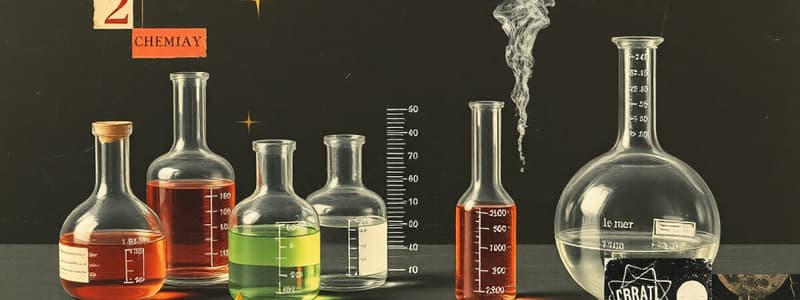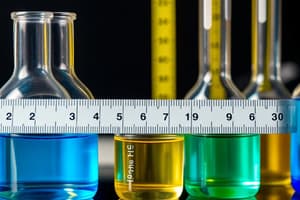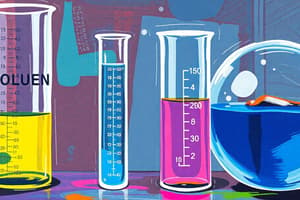Podcast
Questions and Answers
Which of the following is classified as a molecular element?
Which of the following is classified as a molecular element?
- Br2 (correct)
- NaCl
- Fe2O3
- H2O
What characterizes molecular compounds?
What characterizes molecular compounds?
- They contain atoms of the same element.
- They are formed from only nonmetals. (correct)
- They are always solid at room temperature.
- They consist of metal and nonmetal ions.
Which of the following compounds is an ionic compound?
Which of the following compounds is an ionic compound?
- PCl3
- O3
- C2H6O
- Mg2S (correct)
Which of the following elements occurs naturally as a diatomic molecule?
Which of the following elements occurs naturally as a diatomic molecule?
Which of the following is an example of a molecular compound?
Which of the following is an example of a molecular compound?
What is the term for the mass of an individual molecule expressed in atomic mass unit?
What is the term for the mass of an individual molecule expressed in atomic mass unit?
Which of the following is a characteristic of ionic compounds?
Which of the following is a characteristic of ionic compounds?
Which of the following correctly describes ozone?
Which of the following correctly describes ozone?
What is the meaning of the term 'atom' in ancient Greek?
What is the meaning of the term 'atom' in ancient Greek?
What is the primary formula to calculate density?
What is the primary formula to calculate density?
Which measurement units commonly express density?
Which measurement units commonly express density?
What does the nucleus of an atom consist of?
What does the nucleus of an atom consist of?
How can the volume of 1 mL also be expressed?
How can the volume of 1 mL also be expressed?
Which of the following forms of matter does an atom represent?
Which of the following forms of matter does an atom represent?
Which particles are classified as nucleons within the atomic structure?
Which particles are classified as nucleons within the atomic structure?
What factor influences the conversion from grams to picograms in the context of unit sizes?
What factor influences the conversion from grams to picograms in the context of unit sizes?
What is the primary purpose of a molecular equation?
What is the primary purpose of a molecular equation?
When sodium hydroxide and hydrochloric acid react, which ions are present in the resulting ionic equation?
When sodium hydroxide and hydrochloric acid react, which ions are present in the resulting ionic equation?
Which of the following describes a net ionic equation?
Which of the following describes a net ionic equation?
Which statement is true regarding strong electrolytes in solution?
Which statement is true regarding strong electrolytes in solution?
How is the net ionic equation derived from the ionic equation?
How is the net ionic equation derived from the ionic equation?
What is the ultimate product when H+ and OH- ions react?
What is the ultimate product when H+ and OH- ions react?
What is the first step in writing a net ionic equation?
What is the first step in writing a net ionic equation?
What happens to sodium and chloride ions during the reaction of sodium hydroxide with hydrochloric acid?
What happens to sodium and chloride ions during the reaction of sodium hydroxide with hydrochloric acid?
Which system of units is primarily used by scientists for standard measurements?
Which system of units is primarily used by scientists for standard measurements?
When measuring temperature in the SI system, which unit is used?
When measuring temperature in the SI system, which unit is used?
In the metric system, what is the unit for measuring volume?
In the metric system, what is the unit for measuring volume?
Which unit is used for measuring mass in both the metric and SI systems?
Which unit is used for measuring mass in both the metric and SI systems?
Which of the following length measurements is typically smaller than a meter?
Which of the following length measurements is typically smaller than a meter?
Which of the following statements about measuring mass is true?
Which of the following statements about measuring mass is true?
What does the metric prefix 'kilo-' represent?
What does the metric prefix 'kilo-' represent?
What is the primary difference between the metric and Imperial systems of measurement?
What is the primary difference between the metric and Imperial systems of measurement?
What characterizes the formation of an ionic bond?
What characterizes the formation of an ionic bond?
Which of the following best describes a covalent bond?
Which of the following best describes a covalent bond?
In the net ionic equation H+ + OH- → H2O, what does this reaction represent?
In the net ionic equation H+ + OH- → H2O, what does this reaction represent?
What ions are eliminated when writing the net ionic equation for the reaction of silver nitrate and hydrochloric acid?
What ions are eliminated when writing the net ionic equation for the reaction of silver nitrate and hydrochloric acid?
What is the main driving force behind the formation of chemical bonds?
What is the main driving force behind the formation of chemical bonds?
Which of the following types of bonds can involve the sharing of multiple electron pairs?
Which of the following types of bonds can involve the sharing of multiple electron pairs?
Which type of bond is likely to occur between a metal and a nonmetal?
Which type of bond is likely to occur between a metal and a nonmetal?
What distinguishes a double covalent bond from a single covalent bond?
What distinguishes a double covalent bond from a single covalent bond?
Flashcards are hidden until you start studying
Study Notes
Units of Measurement
- Units are standard quantities used to define measurements, which are crucial in chemistry.
- There are three common systems of units: English system, Metric system, and International System of Units (SI).
- SI system is based on the metric system and preferred by scientists.
- The metric system uses one unit for each type of measurement:
- Length: meter (m)
- Volume: liter (L)
- Mass: gram (g)
- Temperature: Celsius (°C)
- Time: second (s)
Measuring Length
- Length is the distance between two points.
- A meter stick is used to measure length.
- Centimeters (cm) are used for smaller lengths.
Measuring Mass
- Mass measures the amount of matter in an object.
- The mass of an object is measured using a balance.
Prefixes
- Prefixes adjust the size of a unit.
- Students should memorize the prefixes, their symbols, and their factors.
- Prefixes that increase the size of the unit: kilo-, mega-, giga-, tera-, peta-
- Prefixes that decrease the size of the unit: deci-, centi-, milli-, micro-, nano-, pico-
Density
- Density of a material is its mass per unit volume.
- Density is typically measured in units of g/L, g/mL, or g/cm3.
- Formula for density: Density = Mass / Volume.
History of Atomic Structure
- The atom comes from the Greek word "atomos," meaning indivisible.
- An atom consists of a nucleus (protons and neutrons) and surrounding electrons.
Molecular Elements
- Molecular Elements occur as multi-atom molecules, with atoms of the same element bonded by covalent bonds.
- Examples: H2, O2, N2, Cl2, P4, S8, Se8
Molecular Compounds
- Molecular Compounds are formed by molecules made of only nonmetals, bonded by covalent bonds.
- Examples: H2O, NH3, HCl, CH4
Ionic Compounds
- Ionic Compounds have particles made of metal cations and nonmetal anions, bonded by ionic bonds.
- Examples: NaCl, AlF3, Fe2O3, Mg2S
Classification of Elements
- Atomic Elements: Composed of individual atoms.
- Molecular Elements: Composed of molecules where atoms of the same element are bonded.
- Molecular Compounds: Composed of molecules where atoms of different elements are bonded.
- Ionic Compounds: Composed of ions of different elements.
Formula Mass and Molar Mass
- Formula mass (amu) is the mass of an individual molecule or formula unit, expressed in atomic mass units (amu).
- Molar mass is the mass of one mole of a substance.
Types of Chemical Equations
- Molecular equations: Show the formulas of compounds as if they existed as molecules.
- Ionic equations: Show the ionic forms of strong electrolytes in solution.
- Net ionic equations: Eliminate spectator ions (those that do not participate in chemical reactions) from the ionic equation, showing only the reacting species.
Writing Net Ionic Equations
- To Write a net ionic equation:
- Balance the molecular equation.
- Write the ionic equation for strong electrolytes.
- Identify precipitates using solubility rules.
- Cancel identical ions on both sides of the ionic equation.
Chemical Bonds
- Compounds are formed by atoms held together by bonds.
- Chemical bonds are attractive forces between atoms.
- Bonds form because they lower the potential energy between charged particles (protons and electrons).
Types of Chemical Bonds
- Ionic bonds: formed when electrons transfer between atoms, resulting in oppositely charged ions.
- Covalent bonds: formed by sharing electrons between atoms.
- Metallic bonds: formed by the attraction of delocalized electrons to a lattice of metal atoms.
Studying That Suits You
Use AI to generate personalized quizzes and flashcards to suit your learning preferences.




